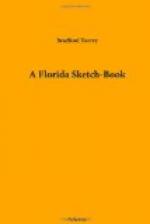[Illustration]
I cannot profess to be sure of that, however, nor have I unqualified confidence in the adequacy of musical notation, no matter how skillfully employed, to convey a truthful idea of any bird song.
[Footnote 1: As it was, I did not find Dendroica virens in Florida. On my way home, in Atlanta, April 20, I saw one bird in a dooryard shade-tree.]
The affair remained a mystery till, in Daytona, nine days afterward, the same notes were heard again, this time in lower trees that did not stand in deep water. Then it transpired that my mysterious warbler was not a warbler at all, but the Carolina chickadee. That was an outcome quite unexpected, although I now remembered that chickadees were in or near the St. Augustine swamp; and what was more to the purpose, I could now discern some relationship between the tee-koi, tee-koo (or, as I now wrote it, see-toi, see-too), and the familiar so-called phoebe whistle of the black-capped titmouse. The Southern bird, I am bound to acknowledge, is much the more accomplished singer of the two. Sometimes he repeats the second dissyllable, making six notes in all. At other times he breaks out with a characteristic volley of fine chickadee notes, and runs without a break into the see-toi, see-too, with a highly pleasing effect. Then if, on the top of this, he doubles the see-too, we have a really prolonged and elaborate musical effort, quite putting into the shade our New England bird’s hear, hear me, sweet and welcome as that always is.
The Southern chickadee, it should be said, is not to be distinguished from its Northern relative—in the bush, I mean—except by its notes. It is slightly smaller, like Southern birds in general, but is practically identical in plumage. Apart from its song, what most impressed me was its scarcity. It was found, sooner or later, wherever I went, I believe, but always in surprisingly small numbers, and I saw only one nest. That was built in a roadside china-tree in Tallahassee, and contained young ones (April 17), as was clear from the conduct of its owners.
It must not be supposed that I left St. Augustine without another search for my unknown “warbler.” The very next morning found me again at the swamp, where for at least an hour I sat and listened. I heard no tee-koi, tee-koo, but was rewarded twice over for my walk. In the first place, before reaching the swamp, I found the third of my flat-wood novelties, the red-cockaded woodpecker. As had happened with the nuthatch and the sparrow, I heard him before seeing him: first some notes, which by themselves would hardly have suggested a woodpecker origin, and then a noise of hammering. Taken together, the two sounds, left little doubt as to their author; and presently I saw him,—or rather them, for there were two birds. I learned nothing about them, either then or afterwards (I saw perhaps eight individuals during my ten weeks’ visit), but




